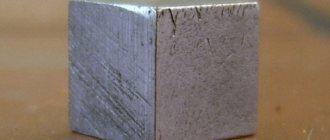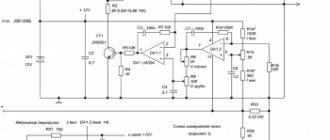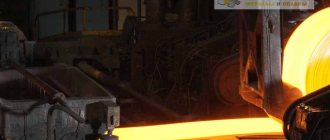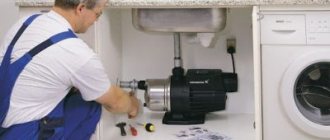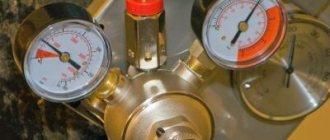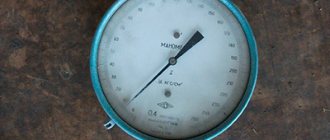Special pressure gauges are designed to work with a specific gas. Such devices usually have colored cases rather than the classic black ones. The color corresponds to the gas with which this device can work. Also, special markings are used on the scale. For example, pressure gauges for measuring ammonia pressure, which are usually installed in industrial refrigeration units, are colored yellow. Such equipment has an accuracy class from 1.0 to 2.5.
A pressure gauge is a compact mechanical device for measuring pressure. Depending on the modification, it can work with air, gas, steam or liquid. There are many types of pressure gauges, based on the principle of taking pressure readings in the medium being measured, each of which has its own application.
Scope of use
Pressure gauges are one of the most common instruments that can be found in various systems:
- Heating boilers.
- Gas pipelines.
- Water pipelines.
- Compressors.
- Autoclaves.
- Cylinders.
- Balloon air rifles, etc.
Externally, the pressure gauge resembles a low cylinder of various diameters, most often 50 mm, which consists of a metal body with a glass lid. Through the glass part you can see a scale with marks in pressure units (Bar or Pa). On the side of the housing there is a tube with an external thread for screwing into the hole of the system in which it is necessary to measure the pressure.
When pressure is injected into the medium being measured, the gas or liquid through the tube presses the internal mechanism of the pressure gauge, which leads to a deflection of the angle of the arrow that points to the scale. The higher the pressure created, the more the needle deflects. The number on the scale where the pointer stops will correspond to the pressure in the system being measured.
Pressure that a pressure gauge can measure
Pressure gauges are universal mechanisms that can be used to measure various values:
- Excess pressure.
- Vacuum pressure.
- Pressure differences.
- Atmospheric pressure.
The use of these devices allows you to control various technological processes and prevent emergency situations. Pressure gauges intended for use in special conditions may have additional housing modifications. This may be explosion protection, resistance to corrosion or increased vibration.
Types of pressure gauges
Pressure gauges are used in many systems where there is pressure, which must be at a clearly defined level. The use of the device allows you to monitor it, since insufficient or excessive exposure can harm various technological processes. In addition, excess pressure causes rupture of containers and pipes. In this regard, several types of pressure gauges designed for specific operating conditions have been created.
They are:
- Exemplary.
- General technical.
- Electric contact.
- Special.
- Self-recording.
- Ship's.
- Railway.
The reference pressure gauge is intended for checking other similar measuring equipment. Such devices determine the level of excess pressure in various environments. Such devices are equipped with a particularly precise mechanism that gives minimal error. Their accuracy class ranges from 0.05 to 0.2.
General technical ones are used in general environments that do not freeze into ice. Such devices have an accuracy class from 1.0 to 2.5. They are resistant to vibration, so they can be installed on transport and heating systems.
Electrical contact ones are designed specifically for monitoring and warning of reaching the upper limit of a dangerous load that can destroy the system. Such devices are used with various media such as liquids, gases and vapors. This equipment has a built-in electrical circuit control mechanism. When excess pressure appears, the pressure gauge gives a signal or mechanically turns off the supply equipment that pumps the pressure. Also, electric contact pressure gauges may include a special valve that relieves pressure to a safe level. Such devices prevent accidents and explosions in boiler rooms.
Special pressure gauges are designed to work with a specific gas. Such devices usually have colored cases rather than the classic black ones. The color corresponds to the gas with which this device can work. Also, special markings are used on the scale. For example, pressure gauges for measuring ammonia pressure, which are usually installed in industrial refrigeration units, are colored yellow. Such equipment has an accuracy class from 1.0 to 2.5.
Recorders are used in areas where it is necessary not only to visually monitor the system pressure, but also to record indicators. They write a chart that can be used to view pressure dynamics over any period of time. Such devices can be found in laboratories, as well as at thermal power plants, canneries and other food enterprises.
Marine gauges include a wide range of pressure gauges that have a weatherproof housing. They can work with liquid, gas or steam. Their names can be found on street gas distributors.
Railway pressure gauges are designed to monitor excess pressure in mechanisms that serve electric rail vehicles. In particular, they are used on hydraulic systems that move rails when extending the boom. Such devices have increased resistance to vibration. Not only do they withstand shock, but the indicator on the scale does not react to mechanical stress on the body, accurately displaying the pressure level in the system.
Types of pressure gauges based on the mechanism for taking readings of pressure in the medium
Pressure gauges also differ in the internal mechanism that results in taking pressure readings in the system to which they are connected. Depending on the device they are:
- Liquid.
- Spring.
- Membrane.
- Electric contact.
- Differential.
Spring pressure gauges are the most common. They have a simple design that is suitable for repair. Their measurement limits usually range from 0.1 to 4000 Bar. The sensitive element of such a mechanism itself is an oval tube, which contracts under pressure. The force pressing on the tube is transmitted through a special mechanism to a pointer, which rotates at a certain angle, pointing to a scale with markings.
The diaphragm pressure gauge operates on the physical principle of pneumatic compensation. Inside the device there is a special membrane, the level of deflection of which depends on the effect of the pressure created. Typically, two membranes are soldered together to form a box. As the volume of the box changes, the sensitive mechanism deflects the arrow.
Differential pressure gauges are among the most complex mechanisms. They work on the principle of measuring deformation inside special blocks. These pressure gauge elements are pressure sensitive. As the block deforms, a special mechanism transmits the changes to an arrow pointing to the scale. The pointer moves until the changes in the system stop and stop at a certain level.
Accuracy class and measurement range
In industrial indicating pressure gauges based on single- and multi-turn springs, transmission mechanisms with a gear sector (tribe-sector) and lever ones are most widespread (Fig. 2.6). A distinctive feature of pressure gauges with a tribco-sector transmission mechanism is a scale with an angle of 270-300 o. This mechanism has a higher cost, but provides increased accuracy of meter readings. It is used in both industrial and reference devices.
Most indicating pressure gauges (pressure gauges, pressure-vacuum gauges and vacuum gauges) with a tubular spring are direct-acting (transformation) devices in which the pressure is sequentially converted into movement of the sensing element and the mechanically indicating device associated with it.
Tubular-spring pressure gauge
called a deformation pressure gauge, in which the sensitive element is a tubular spring /16/.
m-anometric instruments with a tubular spring appeared in the last century. The author of the invention is considered, although there are other contenders, the French engineer Bourdon (see paragraph 2.1). A variation of the Bourdon tube is the tubular spring of the Soviet scientist A.G. Nagatkin, made of a blank with a wall thickness varying around the perimeter.
The tubular spring in low and medium pressure indicating gauges has the shape of a 3/4 circle. For measuring pressures above 6 MPa, a 1.5- and 2.5-turn spring is used. In the latest versions, the reliability of the device is significantly increased and the influence of hysteresis on its accuracy class is reduced.
In a device with a 3/4-tubular spring, tube 1 is bent (Fig. 2.4) with certain internal radii r
and external
R
diameters, depending on the diameter of the measuring device body and the required accuracy class, with a tube bending angle j = 180-300 °.
One end of such a spring is sealed, and the other is connected to holder 2, with the help of which the internal cavity of the tube communicates with the area of measured pressure p
.
Rice.
2.4. Schematic diagram of the sensitive element of a pressure gauge in the form of a single-turn tubular spring: 1
– spring;
2
– holder
Fig.2.5. Scheme of changing the geometry of the sensing element of a spring pressure gauge
In industrial indicating pressure gauges based on single- and multi-turn springs, transmission mechanisms with a gear sector (tribe-sector) and lever ones are most widespread (Fig. 2.6). A distinctive feature of pressure gauges with a tribco-sector transmission mechanism is a scale with an angle of 270-300 o. This mechanism has a higher cost, but provides increased accuracy of meter readings. It is used in both industrial and reference devices.
Rice.
2.6. Simplified diagrams of transmission mechanisms of spring pressure gauges
:
A
– sector,
b
– lever;
1
– tubular spring;
2
– traction (leash);
3
– gear sector;
4
– trib;
5
– arrow
The operating principle of the gear mechanism is as follows (Fig. 2.6a). Moving the free end of a tubular spring through a rod 2
is transmitted to the gear sector
3
, which, through gearing, rotates the trib
4
5
attached to it . Accordingly, the amount of movement of the free end of the sensing element is converted into movement of the arrow.
To eliminate the “free play” of the transmission mechanism, the friction plate is spring-loaded using a spiral hair spring.
Pressure gauges with a lever mechanism are less difficult to adjust, have low sensitivity to vibration, are easy to manufacture and have a lower cost. The scale of a device with a lever transmission mechanism can theoretically be 90 °, but in practice it does not exceed 60-70 °. The accuracy classes of pressure gauge instruments with such mechanisms are 2.5 and 4.0.
The main purpose of adjusting the device is to establish a close to linear dependence of the stroke of the gear sector - trib - index arrow on the measured pressure, as well as compliance of the initial and final scale values with the specified pressure measurement range. This is achieved by varying the length of the rod connecting the SE with the sector, and the length of the lever for engaging this rod on the gear sector. Such adjustment is quite labor-intensive and requires special skills.
The accuracy class of a pressure gauge is mainly determined by the elastic characteristics of the tubular spring and the quality of the gear transmission of the friction-sector mechanism. Thus, the higher the elastic properties of the SE, the better the gearing is made, the higher the accuracy class of the meter can be achieved.
According to GOST 2405-88/4/, pulsating pressure is defined as pressure that repeatedly increases and decreases according to any periodic law at a rate exceeding 10% of the reading range per second. To measure pulsating pressure, it is recommended to use dampers and damping devices (see paragraph 8.2).
Replacing the gear sector under operating conditions is difficult for many imported devices, in which the connections of the transmission mechanism are often made one-piece. Domestic manufacturers provide for the possibility of replacing the tribic-sector transmission mechanism of control and reference devices.
Rice.
2.7. Sectional shapes of a single-turn tubular spring: a
– elliptical;
b
– flat-oval thin-walled;
c
– flat-oval compressed;
g
– flat oval thick-walled;
d
– with eccentric channel;
e
– thick-walled round tube with a flat
An elliptical-section spring is characterized by increased sensitivity, since there are fewer opposing profiles when it extends. Such springs are used by most manufacturers to measure pressures up to 0.1-0.16 MPa, and flat-oval springs are used to measure pressures of 0.16-6 MPa.
Springs with a flat oval compressed profile (Fig. 2.7, c
) are highly durable and can be used to measure high pressure.
In the manufacture of pressure gauges for measuring higher pressures, thick-walled flat-oval springs can be used (Fig. 2.7, d
), which, like flat-oval thin-walled ones, under the influence of pressure change the shape of the transverse sectional shape and, accordingly, the bending radius of the tubular spring.
The static characteristic of the Bourdon spring includes a section of proportionality, when the change in the position of its end depends on the applied pressure, and a subsequent section of residual deformation, when the effect of pressure leads to irreversible changes in the geometry of the sensing element. The maximum operating pressure of a tubular element should be 1.5-2 times less than the limit value of proportionality for industrial devices and 3-4 times for reference ones.
The manufacturing technology of the sensitive element includes thermal annealing of the tube, its profiling and bending (the latter operations can be combined) and mandatory subsequent temperature normalization, designed to relieve stress after mechanical deformation.
Some manufacturers, to prevent irreversible changes in the spring profile at maximum pressure, install a maximum extension limiter along its outer radius.
There is also a known method for eliminating deformation effects by treating the sensitive element with cyclic loads, the so-called physical “aging” of the metal.
Rice. 2.8. View of a multi-turn spring indicating pressure gauge
The technology for manufacturing multi-turn sensitive elements is quite simple. It eliminates the presence of filler during winding, which leads to an arbitrary profile of the tubular element within the bending radius r
.
The methodology for calculating such sensitive elements has not been sufficiently developed.
A pressure gauge is a device that measures the pressure of a liquid or gas.
The principle of operation of the pressure gauge is based on balancing the measured pressure by the force of elastic deformation of a tubular spring or a more sensitive two-plate membrane, one end of which is sealed in a holder, and the other is connected through a rod to a tribic-sector mechanism that converts the linear movement of the elastic sensing element into a circular movement of the indicating arrow.
Depending on their purpose, pressure measuring instruments are divided into the following main groups:
According to the operating principle, all pressure measuring instruments can be divided into the following types:
types of pressure gauges are divided by purpose :
According to their metrological purpose, measuring instruments are divided into standard and working.
- exemplary measuring instruments are devices intended for verification of other measuring instruments;
- working measuring instruments are all measuring instruments used for direct measurements.
Elastic sensitive elements of deformation pressure gauges:
Pressure is the ratio of the force acting perpendicular to a surface to the area of that surface. Pressure largely determines the progress of the technological process, the state of technological devices and their operating modes.
TYPES OF PRESSURE:
- Atmospheric (barometric) pressure is the pressure created by the mass of the air column of the earth's atmosphere.
- Absolute pressure is the total pressure taking into account atmospheric pressure, measured from absolute zero.
- Excess pressure is the difference between absolute and barometric pressure.
- Vacuum (rarefaction) is the difference between barometric and absolute pressure.
- Differential pressure is the difference between two measured pressures, neither of which is ambient pressure.
Based on the type of pressure measured, pressure gauges are divided into:
- overpressure gauges,
- absolute pressure gauges,
- barometers,
- vacuum gauges,
- pressure and vacuum gauges – for measuring excess and vacuum pressure;
- pressure gauges – pressure gauges for low excess pressures (up to 40 kPa);
- draft gauges – vacuum gauges with an upper measurement limit of up to 40 kPa;
- differential pressure gauges – means of measuring pressure difference.
The general principle of operation of pressure gauges is based on balancing the measured pressure by some known force. According to the principle of operation, pressure gauges are divided into:
- liquid pressure gauges;
- spring pressure gauges;
- membrane pressure gauges;
- electrical contact pressure gauges (ECM);
- differential pressure gauges.
PRINCIPLE OF OPERATION OF LIQUID MANOMETER
There is a group of liquid differential pressure gauges in which the level of the working fluid is not directly observed. Changing the latter causes the float to move or the characteristics of another device to change, providing either a direct indication of the measured value using a reading device, or conversion and transmission of its value over a distance.
PRINCIPLE OF OPERATION OF A SPRING MANOMETER
Spring pressure gauges are the most widely used among instruments for measuring pressure. Their advantages are that they are simple in design, reliable and suitable for measuring medium pressure in a wide range from 0.01 to 400 MPa (0.1 to 4000 bar).
Elastic sensitive elements of deformation pressure gauges:
a - tubular springs;
c, d - flat and corrugated membranes;
d - membrane boxes;
e - flaccid membranes with a hard center
PRINCIPLE OF OPERATION OF A DIAPHRAGM PRESSURE GAUGE
The operating principle of a membrane pressure gauge is based on pneumatic compensation, where the force developed by the measured pressure is balanced by the elastic force of the membrane box.
The sensitive element of the device consists of two membranes welded together, forming a membrane box 1. The measured pressure is supplied through a fitting to the internal cavity of the box. Under the influence of the difference between atmospheric and measured pressure, the box changes its volume, which causes the rigid center of the upper membrane to move, which moves the needle of the device 4 through the leash 2 and the lever 3.
PRINCIPLE OF OPERATION OF AN ELECTRIC CONTACT PRESSURE GAUGE
Electrical contact pressure gauges (ECM) are used in automatic control, regulation and alarm systems. Two special arrows, set to the minimum and maximum pressure within the scale, have electrical circuit contacts built into them. When the moving arrow reaches one of the contacts, the circuit closes, which causes a signal to be sent or a corresponding action of the system to which the pressure gauge is connected.
1 — index arrow; 2 and 3 - electrical contact settings; 4 and 5 - zones of closed and open contacts, respectively; 6 and 7 - objects of influence.
Version 1 - single-contact for short circuit;
Version 2 - single-contact opening;
Version 3 - two-contact open-open;
Version 4 - two-contact for short-circuit;
Version 5 - two-contact open-short;
Version 6 - two-contact for short-circuiting.
Electric pressure gauges have a typical operating diagram, which can be illustrated in Fig. a). When the pressure increases and it reaches a certain value, index arrow 1 with an electrical contact enters zone 4 and closes the electrical circuit of the device using base contact 2. Closing the circuit, in turn, leads to the commissioning of impact object 6.
OPERATING PRINCIPLE OF A DIFFERENTIAL PRESSURE GAUGE
Bellows differential pressure gauge type DS:
a - diagram of the bellows block; b - appearance; 1 - working bellows; 2 - silicon organic liquid; 3 - internal cavity of the bellows; 4 - rod; 5 — springs; 6 - fixed glass; 7 — lever; 8 - torenoy; 9 - axis; 10 — rubber rings; 11 - corrugations; 12, 13 - shut-off and equalization valves
In mechanical devices, the main indicator is the location of the arrow, controlled by a lever system. The pointer moves until the changes in the system cease to exert a certain force. A classic example of this system is the DM 3538M series differential pressure gauge, which provides proportional delta (pressure difference) conversion and provides the result to the operator in the form of a unified signal.
(Fig. 1c), multi-turn tubular spring (Fig. 1d), flaccid membrane (Fig. 1e), rigid membrane (Fig. 1f).
In these instruments, the measured pressure or vacuum is balanced by the elastic forces of various sensitive elements, the deformation of which, proportional to the measured parameter, is transmitted through levers to the needle or pen of the device. When the pressure is removed, the sensing element returns to its original position under the influence of elastic deformation.
Figure 1 - Strain gauges
Deformation pressure gauges are widely used in industry due to the simplicity and reliability of their design, clarity of indications, small dimensions, high accuracy and wide measurement limits. A single-turn tubular spring (Fig. 1a), a bellows (Fig. 1b), and a membrane box are used as measuring elements of deformation manometers and measuring transducers of pressure, vacuum and pressure difference
(Fig. 1c), multi-turn tubular spring (Fig. 1d), flaccid membrane (Fig. 1e), rigid membrane (Fig. 1f).
Figure 2 — Tubular-spring deformation pressure gauge
In a tubular-spring pressure gauge with a single-turn tubular spring
A technical pressure gauge is a simple and accurate device for measuring pressure. It can be used to measure vacuum, superatmospheric pressure, pressure difference. The design of the pressure gauge determines how each type of pressure is measured.
Operating principle of a technical pressure gauge
The operating principle of a pressure gauge is based on the fact that a column of liquid of a certain height has a certain pressure. The change in the size of liquid columns when a pressure source is applied to the device is used as an indicator of the change in pressure.
The liquids used in pressure gauges are mostly mercury and water. However, it is possible to use other specially prepared liquids, for example, special oil. For ease of use, colorant is usually added to colorless liquids. The effect of the weight of the dye is negligible and is not taken into account.
Pressure gauges and barometers are used to measure pressure. Barometers are used to measure atmospheric pressure. For other measurements, pressure gauges are used. The word pressure gauge comes from two Greek words: manos - loose, metreo - measure.
Checking pressure based on water flow
The second way to determine pressure is to perform calculations using data on the amount of water flowing from the tap. In addition to this data, you will also need:
- Find out the configuration of the pipeline and determine what material it is made of;
- Calculate the pipe diameter;
- Determine the intensity of liquid leakage;
- Determine the degree of opening of the tap.
To calculate the pressure, you will need a 3-liter measuring container and a stopwatch.
Place the container under the tap and note the time during which it is completely filled with water. It is possible to determine the approximate pressure after the operation, but the results obtained will be very inaccurate. Indeed, in any case, the jar will be completely filled in less than 10 seconds, which is why the resulting pressure value will be significantly less than according to the regulations. However, you should always start from the fact that a 3-liter container will be completely filled with water in 7 seconds or less. In this case, the pressure inside the pipeline will be closest to the regulated one.
Operating principle of a tubular pressure gauge
One end of the tube is sealed. At the other end of the tube, using a tap, it is connected to the vessel in which the pressure needs to be measured. If the pressure begins to increase, the tube will unbend, thereby acting on the lever. The lever is connected to the arrow through a gear, so as the pressure increases, the arrow will deflect, indicating the pressure.
If the pressure decreases, the tube will bend and the arrow will move in the opposite direction.
After assembling the entire system, its functionality is checked. If the slightest sign of a leak appears, the connection should be strengthened, since operation with such defects is strictly prohibited.
How to measure pressure unit correctly
It is worth considering the point that pressure can be measured in a variety of units. The following concepts have become quite widespread:
- Atmospheres.
- Pascals.
- Bars.
To convert one indicator to another, you can use special correspondence tables.
In conclusion, we note that purchased digital pressure gauges are designed for permanent or temporary measurement of key indicators. At the time of operation, the device must be protected from environmental influences, since if damaged, there is a very high probability of a leak.
Bell pressure gauges. Used to measure pressure drops and vacuums.
Didn't find what you were looking for? Use the search:
Best sayings:
A scholarship can buy you something, but nothing more.
8746 – | 7144 – or read all.
91.146.8.87 © studopedia.ru Not the author of the materials posted. But it provides free use. Is there a copyright violation? Write to us | Feedback.
Disable adBlock! and refresh the page (F5)
very necessary
The operating principle is based on balancing the measured pressure or pressure difference with the pressure of a liquid column. They have a simple design and high measurement accuracy, and are widely used as laboratory and calibration instruments. Liquid pressure gauges are divided into: U-shaped, bell and ring.
U-shaped. The principle of operation is based on the law of communicating vessels. They come in two-pipe (1) and single-pipe cups (2).
1) 2)
1) are a glass tube 1 mounted on a board 3 with a scale and filled with a barrier liquid 2. The difference in levels in the elbows is proportional to the measured pressure drop. “-” 1. series of errors: due to inaccuracy in measuring the position of the meniscus, changes in T surrounding. environment, capillarity phenomena (eliminates by introducing corrections). 2. the need for two readings, which leads to an increase in error.
2) rep. is a modification of two-pipe ones, but one elbow is replaced with a wide vessel (cup). Under the influence of excess pressure, the liquid level in the vessel decreases and in the tube increases.
Float U-shaped differential pressure gauges are similar in principle to cup differential pressure gauges, but to measure pressure they use the movement of a float placed in a cup when the liquid level changes. By means of a transmission device, the movement of the float is converted into the movement of the indicating arrow. “+” wide measurement range.
Bell pressure gauges. Used to measure pressure drops and vacuums.
In this device there is a bell 1, suspended on a
carefully stretched spring 2, is partially immersed in separating liquid 3, poured into vessel 4. When P1 = P2, the bell of the device will be in equilibrium. When a pressure difference occurs, equilibrium will be disrupted and a lifting force will appear. will move the bell. As the bell moves, the spring compresses.
Ring pressure gauges. They are used to measure pressure differences, as well as small pressures and vacuums. The action is based on the principle of “ring scales”.
Devices for measuring excess pressure are called manometers, vacuum (pressure below atmospheric) - vacuum gauges, excess pressure and vacuum - pressure and vacuum gauges, pressure difference (difference) - differential pressure gauges.
The main commercially produced devices for measuring pressure are divided into the following groups according to their operating principle:
– liquid – the measured pressure is balanced by the pressure of the liquid column;
– spring – the measured pressure is balanced by the force of elastic deformation of a tubular spring, membrane, bellows, etc.;
– piston – the measured pressure is balanced by the force acting on a piston of a certain cross-section.
Depending on the conditions of use and purpose, the industry produces the following types of pressure measuring devices:
– technical – general purpose instruments for equipment operation;
– control – for checking technical devices at the place of their installation;
– exemplary – for verification of control and technical instruments and measurements that require increased accuracy.
Purpose
. To measure excess pressure, pressure gauges are widely used, the operation of which is based on the use of the deformation of an elastic sensing element that occurs under the influence of the measured pressure. The value of this deformation is transmitted to the reading device of the measuring device, calibrated in units of pressure.
A single-turn tubular spring (Bourdon tube) is most often used as a sensing element of a pressure gauge. Other types of sensitive elements are: multi-turn tubular spring, flat corrugated membrane, harmonic-shaped membrane - bellows.
Device
. Pressure gauges with a single-turn tubular spring are widely used to measure excess pressure in the range of 0.6 - 1600 kgf/cm². The working body of such pressure gauges is a hollow tube of elliptical or oval cross-section, bent around the circumference by 270°.
Rice. 2.64. Indicating pressure gauge with single-turn tubular spring
Electric contact pressure gauges
Purpose.
Pressure gauges, vacuum gauges and electric contact pressure gauges of the type EKM EKV, EKMV and VE-16rb are designed for measuring, signaling or on-off control of pressure (discharge) of gases and liquids neutral in relation to brass and steel. Measuring instruments of the VE-16rb type are made in an explosion-proof housing and can be installed in fire-hazardous and explosive areas. The operating voltage of electrical contact devices is up to 380V AC or up to 220V DC.
Device
.The design of electric contact pressure gauges is similar to spring ones, with the only difference being that the pressure gauge body has large geometric dimensions due to the installation of contact groups. The structure and list of the main elements of electric contact pressure gauges are presented in Fig. 2.65..
Purpose. Model pressure gauges and vacuum gauges of the MO and VO type are intended for testing pressure gauges, vacuum gauges and pressure and vacuum gauges for measuring pressure and vacuum of non-aggressive liquids and gases in laboratory conditions.
Pressure gauges of the MKO type and vacuum gauges of the VKO type are designed to check the serviceability of working pressure gauges at the site of their installation and for control measurements of excess pressure and vacuum.
Rice. 2.65. Electric contact pressure gauges: a – EKM type; ECMV; EKV;
B – type VE – 16 Rb main parts: tubular spring; scale; mobile
Mechanism; group of moving contacts; inlet fitting
Electric pressure gauges
Purpose
. Electric pressure gauges of the DER type are designed to continuously convert excess or vacuum pressure into a unified AC output signal. These devices are used to work in conjunction with secondary differential transformer devices, centralized control machines and other information receivers capable of receiving a standard signal due to mutual inductance.
Operational requirements for pressure gauges for technical purposes:
· when installing the pressure gauge, the tilt of the dial from the vertical should not exceed 15°;
· in the non-working position, the arrow of the measuring device must be in the zero position;
· the pressure gauge has been verified and has a stamp and seal indicating the verification date;
· there is no mechanical damage to the pressure gauge body, threaded part of the fitting, etc.;
· the digital scale is clearly visible to service personnel;
· when measuring the pressure of a moist gaseous medium (gas, air), the tube in front of the pressure gauge is made in the form of a loop in which the moisture condenses;
· a tap or valve must be installed at the point where the measured pressure is taken (in front of the pressure gauge);
· to seal the connection point of the pressure gauge fitting, gaskets made of leather, lead, annealed red copper, and fluoroplastic should be used. The use of tow and red lead is not allowed.
This page was last modified: 2016-08-01; Page copyright infringement
The accuracy class affects not only the measurement error. The ability to operate devices in a particular range also depends on it. Thus, powerful models are not able to detect minimal fluctuations, while ultra-sensitive ones are very susceptible to high “critical” indicators.
Pressure gauge device for measuring water pressure
Design of a pressure gauge
The pressure gauge has a simple design. The device has a body and a scale on which the measured values are marked. The housing contains a tubular spring. It can be replaced with a two-plate membrane. The pressure gauge has a holder, a sensitive element and a tribular-sector mechanism.
The arrow of the device is an indicator. It can make one revolution around its axis. Gears are used to transmit rotation to the arrow. The design of the device contains a gear sector and a leash. Between the gears and teeth of the device there is a special spring, eliminating the possibility of backlash.
Pressure gauge accuracy class
This characteristic must be indicated in the technical data sheet for the device. The accuracy class is expressed in numbers: the lower the digital value in the marking, the higher the accuracy. There are three standard categories:
- With a large error. Accuracy class 4.0. These devices are usually used in car workshops to check the air pressure level in tires.
- Standard, in the range of 1.0-2.5 (normal accuracy class for most models);
- High-precision (exemplary), operating with an error of 0.05.
The accuracy class affects not only the measurement error. The ability to operate devices in a particular range also depends on it. Thus, powerful models are not able to detect minimal fluctuations, while ultra-sensitive ones are very susceptible to high “critical” indicators.
The range of modern models includes devices capable of taking measurements in the range of 0.06-1000 mPa, as well as modifications for measuring vacuum pressure down to a level of -40 kPa.
The company Izmerkon, St. Petersburg, sells digital type pressure gauges, with an LCD display on which the measured values are shown. Such devices operate with high accuracy, within 0.5-0.025%. Among the company's offerings there are also models with additional options - for example, in explosion-proof design.
Sources
Source - https://tehpribory.ru/glavnaia/pribory/manometr.html Source - https://jumas.ru/information/kniga-manometry/2.2.1.php Source - https://www.manomarket.ru/ technical-information Source - https://www.kit-ing.ru/node/181 Source - https://salinc.ru:65082/si/Man3.html Source - https://kipiavp.ru/pribori/tehnicheskiy -manometr.html Source - https://www.nado5.ru/e-book/manometry Source - https://stankiexpert.ru/spravochnik/pnevmatika/cifrovoj-manometr.html Source - https://crast.ru/ instrumenty/zhidkostnye-manometry-naznachenie-ustrojstvo Source - https://izmerkon.ru/podderzhka/publikaczii/manometri-vidi-ustroistvo-osobennosti.html
Types of pressure gauges
Wherever it is necessary to control the pressure level, the installation of such devices is necessary. Otherwise, disruption of technological processes cannot be avoided, which, in turn, can provoke a critical situation. There are 7 groups of pressure gauges depending on the expected operating conditions.
Reference pressure gauges
- To check measuring equipment (other pressure gauges).
- They work with minimal error in different environments.
- Accuracy class – from 0.05 to 0.2.
Electric contact
- Provide control and warning when a critical level of destructive load is reached.
- They work with a built-in power supply control mechanism: when critical loads are reached, the equipment is turned off or the pressure is released to a safe level through a valve.
- Can be used in liquid and gaseous media.
General technical
- Can be used in non-freezing environments.
- They have good resistance to vibration.
- Mounted on transport and heating systems.
- Accuracy class – 1.0-2.5.
Self-recording
- Provide visual monitoring of the system status, as well as recording of indicators.
- The data is recorded in the form of a diagram, from which you can track the pressure level over time.
- They are mainly used in food industry enterprises and thermal power plants.
Special
- For use with special gases (e.g. ammonia, argon)
- They are produced in colored cases, which allows them to be distinguished from other devices.
- Accuracy class – from 1.0 to 2.5.
Railway
- For mechanisms serving electric rail transport.
- They are characterized by increased resistance to vibration.
- Constant mechanical impact on the housing does not lead to distortion of the obtained data.
Ship's
- Supplied in a housing protected from external influences and precipitation.
- They can be installed not only on ships, but also on outdoor gas distributors.
- Suitable for liquid and gaseous media.


